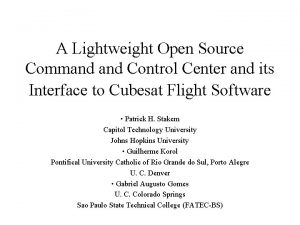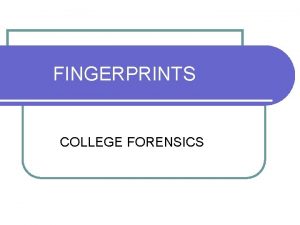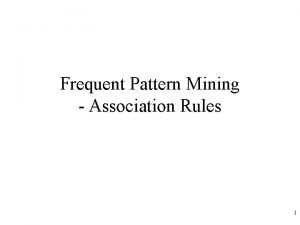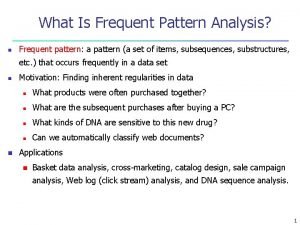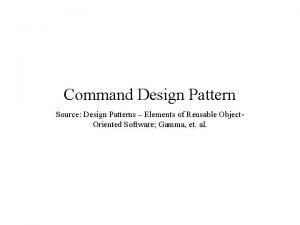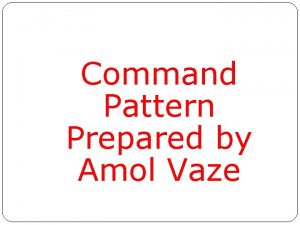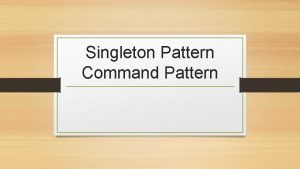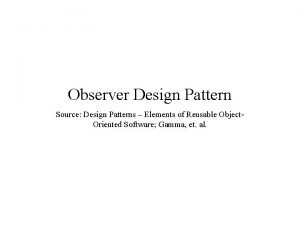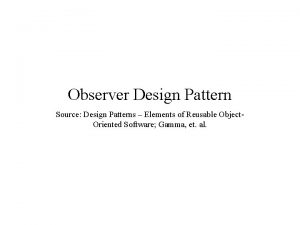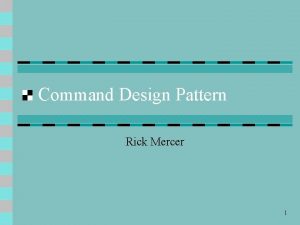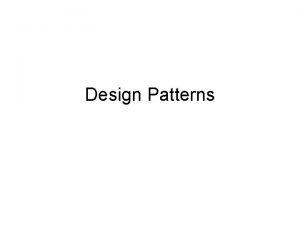Command Design Pattern Source Design Patterns Elements of













- Slides: 13

Command Design Pattern Source: Design Patterns – Elements of Reusable Object. Oriented Software; Gamma, et. al.

Problem • Sometimes a class needs to perform actions without knowing what the actions are

Example: GUI Toolkit • A GUI toolkit provides a full complement of components – Buttons, scroll bars, text boxes, menus, etc. • Toolkit components know how to draw themselves on the screen, but they don't know how to perform application logic • Application developers need a way to associate application logic with GUI components – What should happen when a button is pressed? – What should happen when a menu item is selected? • GUI components need to perform an unknown operation when they are activated by the user

Example: GUI Toolkit

Example: GUI Toolkit

Example: Operations of a Web Application • The different operations/actions supported by a web application can be encapsulated in Command objects • This example also uses the Factory pattern (covered in more detail later), to instantiate and return command instances

Example: Web Application

Example: Web Application

Consequences • Completely decouples objects from the actions they execute • Objects can be parameterized with arbitrary actions • Adding new kinds of actions is easy – Just create a new class that implements the Command interface

Known Uses: Task Scheduling Service • Generic task scheduling service allow tasks to be scheduled by – Interval (e. g. , every hour) – Date/time (e. g. , on February 8 th at 1: 00 pm) – Etc. • Tasks are defined using Command objects • Scheduling service executes Command object at the appropriate time, having no idea what it actually does

Known Uses: Undo/Redo • Store a list of actions performed by the user • Each action has – A “do” method that knows how to perform the action – An “undo” method that knows how to reverse the action • Store a pointer to the most recent action performed by the user • Undo – “undo” the current action and back up the pointer • Redo – move the pointer forward and “redo” the current action

Known Uses: Recording user actions • Macros – Record a sequence of user actions so they can be turned into a macro – Macro can be re-executed on demand by the user

Known Uses: Multi-user network games • Actions performed by a player must be broadcast to all other players and executed on their local machines • How could we use the Command pattern to do this?
 Open source command and control software
Open source command and control software Java command pattern
Java command pattern Dating serves several important functions that include:
Dating serves several important functions that include: Closed patterns and max-patterns
Closed patterns and max-patterns Patterns and pattern classes in digital image processing
Patterns and pattern classes in digital image processing Tented arch fingerprint
Tented arch fingerprint Max pattern and closed pattern
Max pattern and closed pattern Frequent pattern
Frequent pattern Elements and principles of interior design ppt
Elements and principles of interior design ppt Elements of drama performance
Elements of drama performance Elements and sub elements
Elements and sub elements Hydrosulfuric acid
Hydrosulfuric acid Http //elements.wlonk.com/elements table.htm
Http //elements.wlonk.com/elements table.htm What is folktale in literature
What is folktale in literature
